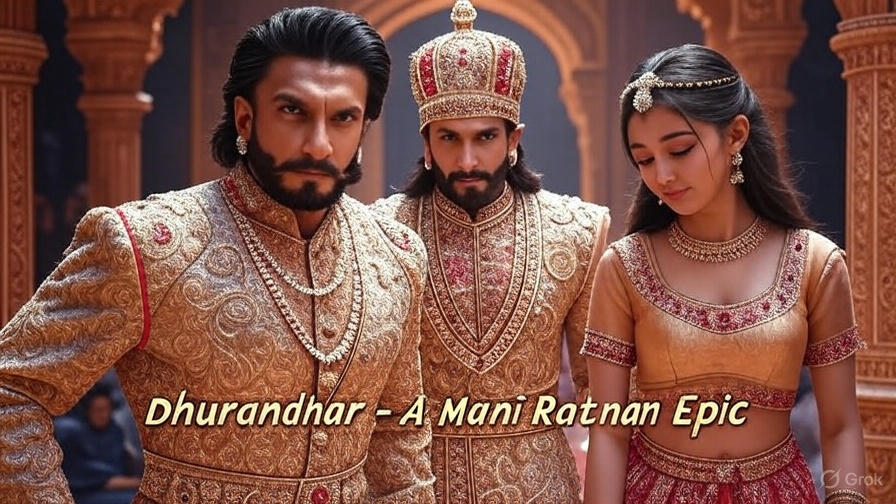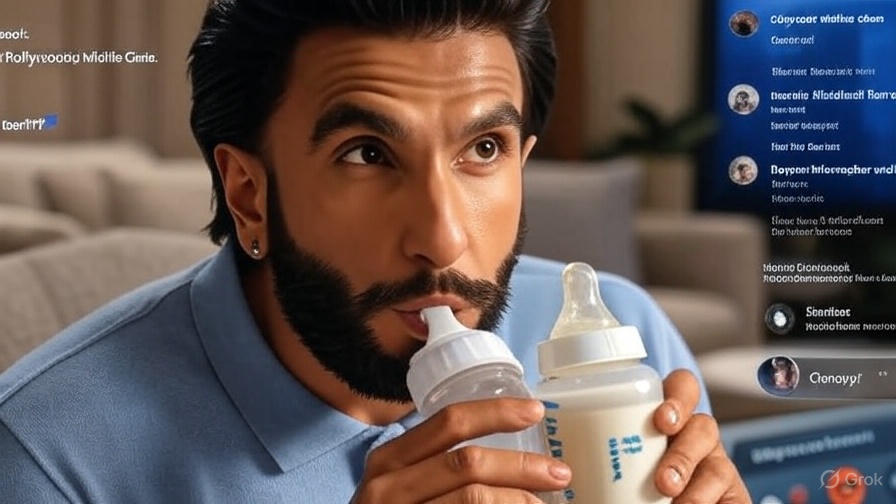
Introduction: The Spark Igniting the Dhurandhar Firestorm
The announcement of Mani Ratnam’s ambitious period epic, Dhurandhar, sent ripples of excitement through Indian cinema. With the powerhouse Ranveer Singh attached to the lead role, expectations soared. However, the casting of the film’s female lead quickly overshadowed the project’s scale, morphining into a heated national debate. The revelation that 20-year-old Sara Arjun would be romantically paired opposite the 40-year-old Singh became the focal point, thrusting Dhurandhar into a contentious spotlight and forcing uncomfortable questions about Bollywood’s entrenched practices. This film isn’t just a historical drama; it’s become a litmus test for the industry’s willingness to evolve.
Sara Arjun: From Child Prodigy to Dhurandhar’s Leading Lady
The choice of Sara Arjun is particularly fascinating, adding layers to the Dhurandhar controversy. As widely reported (Hindustan Times, News18, Mathrubhumi), Arjun isn’t a newcomer plucked from obscurity. She is a former child star, often dubbed one of “India’s richest child actors,” with an impressive pedigree as the daughter of veteran actor Raj Arjun (known for films like “Tanu Weds Manu Returns” and “Secret Superstar”).
- A Prodigious Start: Arjun’s career began exceptionally young, garnering critical acclaim and audience love. Her role as the young Mandodari in the TV epic “Mahabharat” showcased remarkable depth for her age. She further impressed in Mani Ratnam’s own magnum opus, “Ponniyin Selvan” (PS 1 & 2), playing the younger version of Aishwarya Rai Bachchan’s character, Kundavai. This prior collaboration with Ratnam undoubtedly played a role in her casting for Dhurandhar.
- The Transition Challenge: Transitioning from a beloved child actor to an adult lead is notoriously difficult in any film industry. Dhurandhar represents Arjun’s most significant step into mainstream Bollywood as a leading lady. The immense pressure of this debut is now compounded by the intense scrutiny surrounding the age gap with her co-star.
- Public Perception: While her talent is recognized, the public discourse around Dhurandhar often frames her primarily through the lens of her age relative to Ranveer Singh, potentially overshadowing her individual merit and the significant opportunity this role represents for her career.
Ranveer Singh: The Magnetic Force of Dhurandhar
Ranveer Singh needs little introduction. A whirlwind of energy and talent, he has cemented himself as one of Bollywood’s most bankable and versatile superstars. His filmography boasts diverse roles, from the flamboyant Alauddin Khilji in “Padmaavat” to the street rapper Murad in “Gully Boy.”
- The Ratnam-Singh Collaboration: The pairing of Mani Ratnam, a director synonymous with cinematic grandeur and complex narratives, with Ranveer Singh, known for his electrifying screen presence and commitment, was a major selling point for Dhurandhar. Singh’s ability to embody larger-than-life historical/mythical characters made him a seemingly perfect fit for the film’s scale.
- Age and Roles: While Singh has played younger characters, he has also convincingly portrayed older, mature roles. The issue with Dhurandhar isn’t necessarily Singh’s age or capability, but the specific dynamic created by pairing him with an actress half his age in a romantic context, especially when older actresses face diminishing opportunities.
- The Star Power Paradox: Singh’s immense popularity is a double-edged sword in this context. While it guarantees Dhurandhar massive attention and box office potential, it also means the controversy surrounding the casting attracts exponentially more scrutiny and criticism.

Unpacking the Dhurandhar Controversy: The Core Arguments
When Hindustan Times broke the casting news, Reddit erupted over Ranveer (43) and Sara’s (28) age. The articles from Hindustan Times, News18, and Mathrubhumi perfectly encapsulate the multifaceted outrage and discussion:
- The Glaring Age Gap (20 vs. 40): This is the undeniable core. A two-decade age difference for a romantic pairing immediately raises eyebrows. Critics argue it perpetuates the normalized, often invisible, ageism in Bollywood where leading men routinely romance women significantly younger, while actresses over 35 struggle to find substantial roles, let alone romantic leads opposite younger men.
- The “Creepiness” Factor: Many find the pairing inherently uncomfortable or “creepy,” especially given Arjun’s recent transition from child roles. The power dynamic – a mega-star paired with a much younger, relatively inexperienced actress making her adult debut – amplifies this discomfort. As Mathrubhumi’s headline starkly asks, “What’s wrong with Bollywood?”
- Perpetuating a Toxic Norm: Critics see Dhurandhar as emblematic of a deep-seated industry problem. News18’s coverage highlights the phrase “romances actress 20 years younger,” framing it not as an anomaly but as a recurring, problematic trope. It reinforces the idea that a woman’s value on screen is tied to youth, while men age into “distinguished” roles without similar constraints.
- The Waste of Talent Pool: A significant argument is the sidelining of numerous talented, age-appropriate actresses. Why cast a 20-year-old opposite a 40-year-old when there are countless brilliant actresses in their 30s and early 40s who could bring depth, experience, and a more believable dynamic to the role? This is seen as a missed opportunity for Dhurandhar and a systemic issue.
- Mani Ratnam’s Role: The controversy stings more because Ratnam is considered an auteur, known for crafting strong female characters (e.g., “Dil Se..”, “OK Kanmani”, “PS”). His involvement in Dhurandhar‘s casting choice leads to accusations of hypocrisy or, at the very least, a disappointing adherence to commercial pressures over progressive ideals. Mathrubhumi explicitly ties the debate to him.
- Defense and Counter-Arguments: Proponents argue:
- Character Requirement: The role might specifically require a character portrayed as very young.
- Talent First: Arjun was chosen for her talent and suitability for the role, not just her age.
- Director’s Vision: Ratnam has a specific vision for the dynamic between the characters.
- Precedent in History/Myth: Some historical/mythical stories involve large age gaps (though this often ignores the problematic nature of those original contexts).
- “Chemistry Matters”: The nebulous argument that the actors’ chemistry on screen is paramount, regardless of real-world age.
Bollywood’s Age Gap Problem: A Deep-Rooted Tradition
The Dhurandhar controversy isn’t happening in a vacuum. It’s a symptom of a chronic illness plaguing Bollywood (and many global film industries):
- The Double Standard: Male stars like Amitabh Bachchan, Shah Rukh Khan, Salman Khan, Ajay Devgn, and Akshay Kumar have consistently romanced actresses decades younger throughout their careers. This longevity for men contrasts sharply with the truncated careers of their female contemporaries.
- The Disappearing Actresses: Where are the leading roles for Kajol, Raveena Tandon, Karisma Kapoor, Juhi Chawla, or even slightly younger stars like Priyanka Chopra or Kareena Kapoor Khan in mainstream Bollywood romances opposite A-list male contemporaries? They often shift to character roles, OTT projects, or see their opportunities vanish.
- The “Pairing” Logic: The industry often prioritizes pairing established male stars with fresh female faces perceived as more “bankable” or “appealing” to younger demographics, perpetuating the cycle.
- Audience Complicity?: While outrage exists, films featuring such pairings often succeed commercially, suggesting a segment of the audience either doesn’t mind or doesn’t critically engage with the dynamic. Dhurandhar will be a key test case.
Beyond Bollywood: The Global Context
While Bollywood’s age gap issue is particularly stark, Hollywood is far from blameless. Think of Harrison Ford and Calista Flockhart (~22 years), Alec Baldwin and Hilaria Baldwin (~26 years), Bruce Willis and Emma Heming (~23 years) in their real lives, or numerous on-screen pairings. However, Hollywood has seen a noticeable, if slow, shift:
- Increasing Criticism: Films featuring large age gaps face louder public and critical backlash.
- More Diverse Roles for Women: While problems persist, platforms like HBO, Netflix, and Amazon have created more complex leading roles for older actresses (e.g., Nicole Kidman, Reese Witherspoon, Laura Linney).
- Conscious Casting: Some filmmakers are making more conscious efforts to cast age-appropriate partners (though this is still not the norm). Bollywood lags significantly in this regard, making Dhurandhar feel like a step backwards for many.
Social Media Erupts: The Dhurandhar Discourse Online
The reaction to the Dhurandhar casting has been loud and polarized on social media:
- Outrage and Disappointment: Hashtags criticizing the age gap and calling out Ratnam and the producers trended. Comments highlight the hypocrisy (“Imagine if it was a 40-year-old actress with a 20-year-old male star!”) and lament the lost opportunities for older actresses. Memes mocking the pairing went viral.
- Defending the Casting: Supporters praised Arjun’s talent, emphasized Ratnam’s track record, argued for artistic freedom, or simply stated they were excited to see Singh in a Ratnam epic regardless. Some dismissed the criticism as “woke culture” overreach.
- Focus on Sara: Many expressed concern for Sara Arjun, hoping the intense scrutiny wouldn’t negatively impact her big break or subject her to unfair pressure and online toxicity.
The Silence and the Stakes: Awaiting Responses
As of now, there haven’t been major official statements directly addressing the age gap controversy from Mani Ratnam, Ranveer Singh, Sara Arjun, or the Dhurandhar producers. This silence is telling. They likely hope the discourse will fade as production progresses or that the final film’s quality will override the criticism.
The stakes are high for Dhurandhar:
- Box Office: Will the controversy deter a segment of the audience, or will the combined power of Ratnam and Singh prevail?
- Critical Reception: Will critics view the film through the lens of this casting controversy, potentially overshadowing its artistic merits?
- Legacy: Could this become a defining, negative association for the film, regardless of its quality?
- Sara Arjun’s Career: Will this launchpad propel her to stardom, or will she be forever defined by this controversial debut?
- Industry Impact: Will Dhurandhar‘s experience (success or failure) force producers to reconsider such casting choices in the future, or will it reinforce the status quo?
Conclusion: Dhurandhar – A Crossroads for Bollywood?
Dhurandhar arrived promising spectacle and the magic of a Mani Ratnam-Ranveer Singh collaboration. Instead, it inadvertently became the epicenter of a crucial cultural conversation. The casting of Sara Arjun opposite Ranveer Singh is more than just a personnel decision; it’s a stark reflection of Bollywood’s deeply ingrained, uncomfortable truths about gender, age, and opportunity.
The outrage isn’t about Ranveer Singh’s talent or Sara Arjun’s potential. It’s about a system that routinely sidelines talented, experienced women past an arbitrary age while allowing their male counterparts decades-long reigns as romantic leads. It’s about the normalization of dynamics that feel inherently unequal and often jarring on screen. It’s about demanding better from an industry with immense cultural influence.
Whether Dhurandhar succeeds or fails, the debate it has ignited is necessary and overdue. It forces audiences and the industry to confront an inconvenient reality. Will Dhurandhar be remembered as a magnificent period epic, or as the film that highlighted Bollywood’s persistent ageism? The answer lies partly in the film itself, but more significantly, in whether this controversy sparks tangible change in casting couches and boardrooms. The spotlight is now firmly on Dhurandhar, not just for its story, but for the story it tells about the industry that created it. The hope is that this firestorm leads not to ashes, but to a long-awaited evolution.
